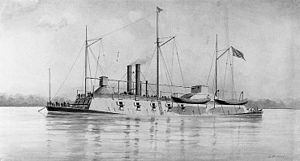USS Benton (1861)

USS Benton
|
|
| History | |
|---|---|
|
|
|
| Namesake: | American senator Thomas Hart Benton |
| Builder: | James B. Eads, St. Louis, Missouri |
| Laid down: | date unknown |
| Acquired: | early November 1861 for $2,600 USD |
| Commissioned: | February 24, 1862 |
| Decommissioned: | July 20, 1865 |
| Struck: | 1865 (est.) |
| Fate: | sold November 29, 1865 |
| General characteristics | |
| Displacement: | 633 long tons (643 t) |
| Length: | 202 ft (62 m) |
| Beam: | 72 ft (22 m) |
| Draught: | 9 ft (2.7 m) |
| Propulsion: |
|
| Speed: | 5.5 knots |
| Complement: | 176 officers and enlisted |
| Armament: | (see section below) |
| Armor: |
|
USS Benton (1861) was an ironclad river gunboat in the United States Navy during the American Civil War. She was named for American senator Thomas Hart Benton. Benton was a former center-wheel catamaran snagboat and was converted by James B. Eads, St. Louis, Missouri, in 1861 and commissioned February 24, 1862 as part of the Army's Western Gunboat Flotilla.
On April 29, 1861 Secretary of the Navy Gideon Welles received correspondence from James Eads concerning the viability of converting Submarine No. 7 into a riverine warship for the U.S. military. Submarine No. 7 was a snagboat built by the US Navy that had been purchased by Eads' Missouri Wrecking Company and modified to raise sunken steamboats on the Mississippi River. Both hulls of Submarine No. 7 were divided into 7 watertight compartments and Eads argued that the vessel could suffer up to 20 penetrating shot into 4 of these compartments and still stay afloat. (Other sources state she was built with 40 watertight compartments.) Additionally he argued that the vessel would be able to support a strong battery of 32-pounder cannons. His initial proposal called converting the vessel into a Cotton-clad gunboat for a cost of $3,000 in cotton. His letter also described a plan to convert two other, smaller vessels and to create a naval base at Cairo, IL.
Lacking the resources to undertake the project, Welles forwarded Eads's letter to the Secretary of War Simon Cameron. Cameron was impressed by the proposal and forwarded it to General George McClellan to implement the construction of the base. Instead of the cotton-clad boat however, the US Army wanted a fleet of new ships; this became the City-class ironclad fleet.
...
Wikipedia
